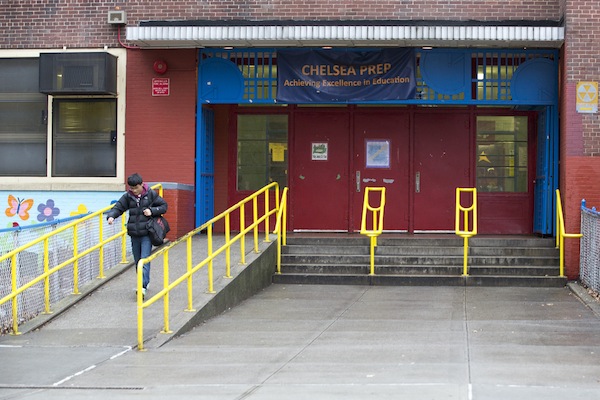
Photo by: Marc Fader
P.S. 33 in Chelsea is one of 750 schools in the city deemed accessible, thanks in part to the ramp seen above. But more than 1,000 schools are not on the list of accessible facilities.
Two weeks ago City Limits published an investigation by Ben Adler of Mayor Bloomberg’s record on disability policy, which included harsh criticism from many advocates who think the administration (and non-mayoral agencies, like the MTA) have been cavalier toward the needs of the disabled when it comes to taxis, transit, schools, workforce development and emergency evacuation.
Reporter Jack Curran then contacted all the mayoral campaigns to see if any of the candidates planned to do anything differently when they get into City Hall. While some of those running—like Comptroller John Liu, who blocked a contract for the city’s Taxi of Tomorrow plan—have taken public stands on issues that affect the disabled, we wanted to hear their answers to specific questions.
To date, only one candidate—former Brooklyn City Councilman Sal Albanese, a Democrat—got back to us. Here’s what he said:
City Limits: What is your position on accessible taxis?
Sal Albanese: Every New Yorker deserves to be able to get where they need to go as rapidly as possible, no matter how they travel. In cities that we compete with, like London, entire taxi fleets are accessible to disabled riders. While the United States’s accessibility laws are more stringent, that is no excuse for New York City to lag behind. Unfortunately, retrofitting our existing fleet or undoing Mayor Bloomberg’s “Taxi of Tomorrow” design would cost millions of dollars that are better used by other programs that empower the disabled. The next round of new vehicles, however, must be accessible. Had I been in Bloomberg’s shoes, I would have committed to a firm deadline for phasing in an all-accessible fleet. Taxis aren’t the end-all, be-all of transportation. It’s absurd that less than 25 percent of subway stations are wheelchair-accessible. Entire communities, especially the elderly or disabled, are denied access to our subway system. I’m advocating city control of the mass transit system, which would finally allow disabled New Yorkers to hold their local elected officials accountable and put accessibility at the top of the agenda.
City Limits: What is your position on the extent of access to schools and school outcomes for disabled students?
Sal Albanese: As a former public school teacher, I’ve seen first-hand the difficulties that disabled and non-disabled students alike face in getting the attention and resources they need from our schools. With fewer than 50 percent of public school buildings accessible, it is no wonder that disabled students graduate on time at less than half of the rate of their peers. We have to ensure that accessibility is a top priority when remodeling, rebuilding, or opening new schools. As the recent school bus strike indicated, addressing the transportation obstacles facing disabled and special education students could also go a long way toward saving the city money and improving access to education. Beyond brick-and-mortar improvements, we need to ensure that our Individualized Education Programs work aggressively to meet compliance requirements, which even the DOE admits they are not. Most importantly, it’s time for the city to finally take advantage of cutting-edge technologies that make lessons, textbooks, and other materials easily accessible to every New York City student.
City Limits: What is your position on Workforce1 and career development for the disabled?
Sal Albanese: The single best way to help New Yorkers, disabled and non-disabled alike, find employment is to create good living wage jobs right here in the city. That is a cornerstone of my campaign. In the short-term, the city can drastically improve existing services. Our One-Stop and Workforce1 centers need to bolster their outreach and service to disabled New Yorkers seeking work. Joining New York State’s DRC program is a good first step.
City Limits: What is your position on emergency evacuation planning for the disabled?
Sal Albanese: Despite ten years of warnings, our city was utterly unprepared to handle the crisis during and after Hurricane Sandy hit. Disabled New Yorkers know this better than anyone. Outdated flood maps and high-rises without power left many stranded with no plan for getting them out. Those that were able to evacuate encountered shelters without ramps. Even using bathrooms posed a major challenge. In a city like ours, that is simply unacceptable. As mayor, I will appoint a Deputy Mayor of Infrastructure and finally make infrastructure investments a priority. I will direct him or her to ensure that projects that protect our buildings and coasts better enable disabled residents to evacuate. I will also direct the Office of Emergency Management and relevant agencies to draw up evacuation plans that make absolutely clear how New Yorkers with sensory and physical disabilities can prepare and who they can count on in the event of another major storm.








